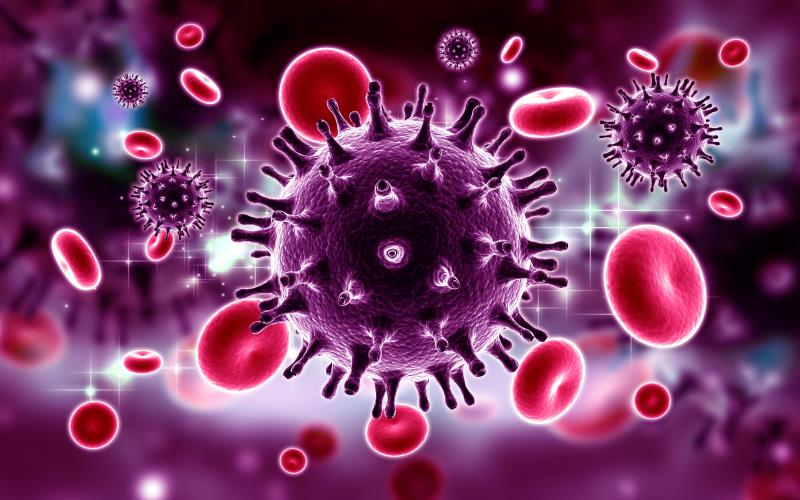Dolutegravir plus lamivudine suppresses HIV without HBV reactivation





The two-drug regimen dolutegravir plus lamivudine (DTG/3TC) is as good as 3- or 4-drug antiretroviral therapy (ART) regimens at keeping viral load suppressed while helping avoid hepatitis B virus (HBV) reactivation in people living with HIV-1 who have past exposure to HBV but no immunity, according to a post hoc analysis of five phase 3/3b studies.
ART-naïve participants
In the GEMINI-1 and -2 studies, the rates of HIV-1 suppression were high and comparable between DTG/3TC and the three-drug regimen DTG plus tenofovir alafenamide (TAF)/emtricitabine (FTC) through 144 weeks. This held true even when the more stringent HIV-1 RNA measure represented by “target not detected” (TND) was used, reported lead study author Dainielle Fox, PharmD, from ViiV Healthcare in Durham, North Carolina.
The proportion of participants with HIV-1 RNA <50 c/mL in the DTG/3TC arm was 83 percent at week 48, 78 percent at week 96, and 78 percent at week 144. In the DTG/TDF/FTC arm, the corresponding proportions were 96 percent, 87 percent, and 74 percent. [AIDS 2024, abstract OAB0106LB]
Meanwhile, HIV-1 RNA <40 c/mL plus TND occurred in 65 percent of participants at week 48, 61 percent at week 96, and 70 percent at week 144 in the in the DTG/3TC arm, and in 74 percent, 65 percent, and 57 percent, respectively, in the DTG/TDF/FTC arm.
In the single-arm STAT study, 60 percent of participants achieved HIV-1 RNA <50 c/mL with DTG/3TC.
Only a few participants had a viral load of ≥50 c/mL with DTG/3TC: three patients at week 48, two patients at week 96, and two patients at week 144 in GEMINI-1; and two patients at week 48 in STAT.
GEMINI-1 and -2 included 46 participants (DTG/3TC: n=23, median age 38 years, 91 percent male; DTG/TDF/FTC: n=23, median age 42 years, 96 percent male), while STAT had five (median age 46 years, 100 percent male). These studies, according to Fox, looked at adults living with HIV who had isolated reactive hepatitis B core antibody (anti-HBc), no immunity to HBV, no evidence of active HBV infection, and were naïve to ART.
Virologically suppressed participants
In the TANGO and SALSA studies, switching to DTG/3TC resulted in high and similar rates of HIV-1 suppression when compared with continuing 3- or 4-drug comparator regimens. This finding remained consistent even when applying the more stringent TND criterion for HIV-1 RNA, Fox said.
The rates of HIV-1 RNA <50 c/mL were 94 percent at week 48, 89 percent at week 96, and 89 percent at week 144 among participants who switched to DTG/3TC. The corresponding rates among those who continued with their current ART regimen were 100 percent, 100 percent, and 75 percent.
HIV-1 RNA <40 c/mL plus TND was documented in 94 percent at week 48, 78 percent at week 96, and 56 percent at week 144 among participants who switched to DTG/3TC, and in 78 percent, 100 percent, and 75 percent, respectively, among those who continued with their current ART regimen.
In TANGO, specifically, virologic suppression rates were high across the early-switch (HIV-1 RNA <50 c/mL: 89 percent; HIV-1 RNA <40 c/mL plus TND: 89 percent) and late-switch (HIV-1 RNA <50 c/mL: 100 percent; HIV-1 RNA <40 c/mL plus TND: 67 percent) arms, Fox noted.
“No participants had HIV-1 RNA ≥50 c/mL at week 48 in TANGO/SALSA or at weeks 96, 144, or 196 in TANGO, regardless of early or late switch to DTG/3TC,” she added.
TANGO and SALSA included 13 and 12 participants, respectively. Of these, 16 switched to DTG/3TC (median age 47 years, 100 percent male) and nine continued with their current ART regimen (median age 47 years, 67 percent male). These were virologically suppressed people living with HIV who had isolated reactive anti-HBc, no immunity to HBV, and no evidence of active HBV infection.
Safety
“Across all studies, the majority of liver chemistry test elevations reported were grades 1 and 2 or mild and moderate,” Fox said.
One participant on DTG/3TC in GEMINI-1 and -2 had hepatitis E and liver enzyme elevations that met the liver-stopping criteria, she pointed out. “This participant discontinued treatment and withdrew from the study at week 144.”
Adverse events (AEs) of any grade typically associated with HBV were reported in 22 percent participants on DTG/3TC in GEMINI-1/-2 and in 6 percent of those on DTG/3TC in TANGO/SALSA. These AEs included eosinophilia (n=2), lymphadenopathy (n=2), lymphocytosis (n=1), macrocytic anaemia (n=1), and splenomegaly (n=1).
“There were no instances of hepatitis B reactivation in any study,” Fox said.
“Overall, these results support the safety and efficacy of DTG/3TC in people living with HIV who have an isolated reactive anti-HBc [and have not yet demonstrated immunity to HBV],” she continued. “The clinical management of this population … is important to prevent clinical progression of liver disease and potential for HBV reactivation and or liver-associated complications.”
Fox declared a financial interest in GSK through stock ownership.